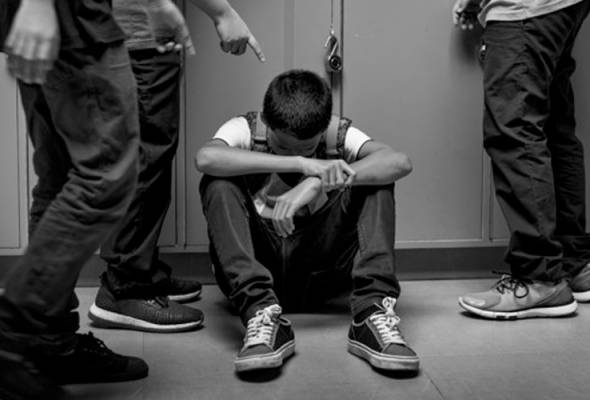
Published in Astro Awani & Asia News Today, image by Astro Awani.
Recently, a bitterly disappointing case of child bullying took place at Sultan Azlan Shah Mara Junior Science College (MRSM) in Kuala Kangsar, Perak. After watching several short videos of bullying that were leaked on social media (i.e., Facebook and Twitter), the public – outraged and in uproar – took keen interest in the case which then pressured the police to take immediate action.
As of now, the police have detained 10 children between the ages of 13 and 15 to facilitate investigations into this case (Section 2 of the Children Act 2001 defines a “child” as a person under the age of 18).
Watching the video recording of the bullying incident makes for a distressing experience and which immediately evoke outright sympathy for the victim. The helpless and hapless appearance of the bullied child in the video is a vivid portrayal and depiction of all the victims of bullying around us.
Therefore, this case should be a warning that we must pay closer attention to child bullying and put in more efforts to tackle and combat this issue, with a view to achieving “zero child bullying” someday in our nation.
More often than not, the root causes of bullying are assertions of personal dominance (i.e., the exercise of power through brute force to satisfy the ego of the bully), insecurity issues (i.e., seeking a sense of belonging and attachment to a group and turning its attention outwards by attacking others ferociously), and desire to be noticed by someone (e.g., teachers and parents).
Common bullying behaviours and patterns among children are physical bullying (e.g., punching, kicking and damaging property) and verbal bullying (e.g., insults, intimidation and racist remarks).
These bullying behaviours cause not only (permanent) physical and mental harm to the victims, but also the loss of property and even life.
For instance, a 17-year-old Johor teen chose to commit suicide in 2020 as he could not stand the physical bullying from two classmates.
Looking back to 2002, a 13-year-old teen impulsively killed an 11-year-old girl when the latter taunted the former by calling him “fatty” and “stupid,” which in turn ruined his future even though he was the one being bullied.
Furthermore, in a world where networking is here to stay, one cannot deny that cyberbullying – including sharing malicious contents or rumours on social media – is emerging among children. This is because children are now closely connected with the online world, especially during the pandemic, as they need to adopt and adapt to online learning. This undoubtedly provides them with an opportunity to engage in cyberbullying.
According to the United Nations International Children’s Emergency Fund (UNICEF), one-third of the world’s Internet users are under 18. Moreover, the average age of first time surfing the Internet is declining.
Therefore, many children around the world are exposed to the risk of cyberbullying.
On top of that, 29% of children aged 14 years old and below and 30% of those aged between 15 to 19 years old in Malaysia have experienced cyberbullying, according to the recent report (as of June 2019) published by the U-Report Malaysia.
These data show that cyberbullying is gradually becoming a silent killer of children if no proactive actions are taken.
Currently, there are three Acts cited/referred by the judiciary against child bullies and for protection of the victims, which are the Penal Code (e.g., sections 147, 499, 503 and 507), Child Act 2001 (e.g., section 75) and Communication and Multimedia Act 1998 (e.g., section 233).
Nonetheless, some of these legal provisions provide child bullies room to evade culpability and do not effectively protect and safeguard the victims.
For instance, in pursuance of Sections 82 and 83 of the Penal Code, children under 10 and those aged between 10 and 12 years old who have not yet reached sufficient mature understanding to reason and discern the laws of nature and consequences of their actions on that occasion would not be charged.
Moreover, according to Section 74 of the Child Act 2001, children below the age of 14 will not be sent to the “infamous” Henry Gurney School – a place to take in and monitor juvenile offenders – even if they are found guilty of any offence punishable with imprisonment.
Now, these legal provisions that provide “breathing space” for underaged bullies should – ideally – be uniformly amended for children below the age of 9.
This is because one cannot dismiss the possibility that some primary school students deliberately participate in bullying as they think that the “cost” (i.e., punishment) for bullying is negligible.
In the meantime, bullies and abettors or instigators below the age of 14 should be forcibly sent to Henry Gurney School to enrol in the “behaviour and mental rehabilitation” programmes, and the duration is judged according to the severity of the offence.
That is to say, the legal provisions should be intensified to eliminate all “loopholes” that allow these underaged bullies, especially with reference to those engaged in serious cases, to be exempted from criminal liability.
To further address the child bullying issue, EMIR Research would like to propose the following policy recommendations for consideration to supplement and complement the above:
1. Establish an Online Anonymous Reporting Platform
Generally, the victims of bullying often suffer in silence as they are afraid that their report will lead to more cruel retaliation from the bullies.
Hence, creating a safe reporting environment for the victims is an imperative/an urgent priority to ensure that all the reports are appropriately handled.
To fully protect the victims, the government is advised to set up an online bullying reporting platform with the feature of hiding the victims’ sensitive personal data – in addition to the making of a police report, as is customary.
Besides that, the platform should also allow for calls to be made as like in a 999 number. Calls should operate 24/7 – at least for a period – to avoid missing the victims’ call for help and could be manned by government staff under the Ministry of Home Affairs, Ministry of Education and Ministry of Women, Family & Community Development.
Meanwhile, the operators should have the ability to counsel and offer psychological help to the victims and guide them to safeguard themselves in the future.
When processing the report, all parties – including the authorities, police, schools and parents – should collect evidence in a low-key manner (i.e., without attracting too much attention). This is to avoid any repercussions that could derail further investigations such as public fury manifested in mob or vigilante justice, for example.
Also, if actions are taken against the bullies, they should make sure that the bullies do not have any chance to approach the victims afterwards.
Also, this platform could adopt blockchain technology to promote transparency and accountability regarding the report’s processing progress until the case is closed.
Therefore, victims need not worry that they would not be able to find a secure channel to complain about the sufferings they face, and that their reports will fall on deaf ears.
2. Mandatory Requirement for the Schools to Organise Anti-Bullying Campaign Every Year
Similar to the fire drills organised by the schools and the Fire and Rescue Department of Malaysia (Bomba) every year, an anti-bullying campaign should be held once a year to continuously raise and sustain students’ awareness.
During the campaign period, the schools can cooperate with the police officers from neighbouring police stations to hold road shows that include speeches regarding the consequences of being involved in bullying. The police can help to spread the influence of anti-bullying in schools and deter students with bullying intentions.
Schools can also request former victims of bullying to voluntarily share their personal experiences and ways to escape bullying in front of students. This move is to help the existing victims in the schools to understand that they still have a precious chance in life and it is “not the end of the world” and therefore, they should give up their suicidal thoughts.
Additionally, an anti-bullying campaign is a good channel for victims to know about the resources provided by the school, such as counselling and other forms of support. The schools can take this opportunity to encourage students to make good use of the resources provided.
In a nutshell, proactive and concerted actions by the authorities are needed to deal with child bullying to achieve the target of “zero child bullying” in our community.
Jason Loh Seong Wei and Tan Tze Yong are part of the research team of EMIR Research, an independent think tank focused on strategic policy recommendations based on rigorous research.

